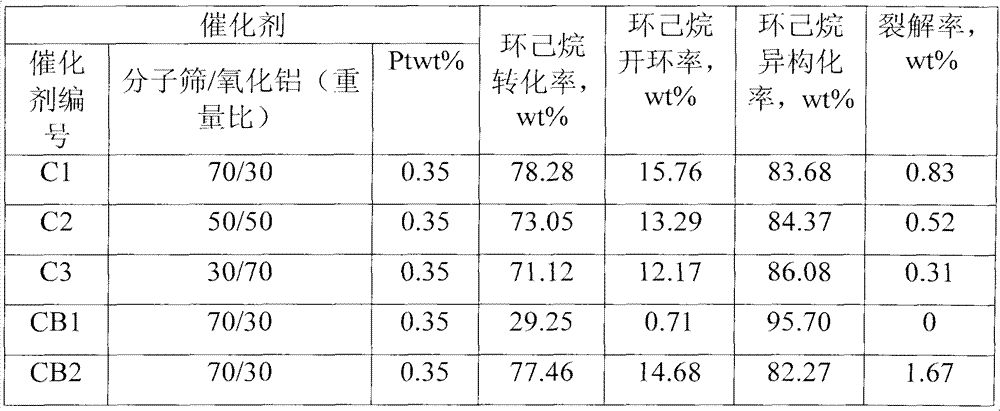Naphthenic hydrocarbon hydro-conversion catalyst and preparation method and application thereof
A hydrogenation conversion and catalyst technology, which is applied in the direction of catalyst activation/preparation, physical/chemical process catalyst, molecular sieve catalyst, etc., can solve the problems of difficult post-treatment process and poor hydrothermal stability, and achieve low catalyst cost and cyclohexane Effect of low isomerization rate and high cyclohexane conversion rate
- Summary
- Abstract
- Description
- Claims
- Application Information
AI Technical Summary
Problems solved by technology
Method used
Image
Examples
Embodiment 1
[0026] (1) Synthesis of Y-Beta Composite Molecular Sieve
[0027] In the first step, 12.5g Y molecular sieves are added to a solution of 0.65g sodium hydroxide, 10.8g TEABr (tetraethylammonium bromide), and 4.0ml concentrated ammonia water (25% by weight), and stirred for 0.5 hours to mix well.
[0028] In the second step, 10.0ml silica sol (SiO 2 30% by weight) and 41ml of distilled water were added to the above solution and stirred for 1 hour.
[0029] The third step is to put the above-mentioned white jelly into a 150ml stainless steel reaction kettle, crystallize at 140°C for 90 hours, take it out, wash until the solution is neutral, and then dry it. The prepared samples were calcined at 550°C for 4h to remove the templating agent. Obtain Y-Beta composite zeolite molecular sieve.
[0030] (2) Treatment of Y-Beta composite molecular sieve
[0031] Take 200 grams of Y-Beta composite molecular sieves prepared in step (1) respectively, and exchange 3 times at 80° C. for 2 ...
Embodiment 2
[0035] Get 50 grams of hydrogen-type Y-Beta composite molecular sieves prepared in Example 1, 69 grams of SB powder, and 2.50 grams of scallop powder, mix well, then add 60ml of deionized water and 2.50ml of concentrated nitric acid (66.5w%) on the roller compactor Fully knead to make it into a paste-like plastic, extrude a cylindrical strip with a diameter of 1.5mm on the extruder, dry at 110°C for 8 hours, and then bake at 550°C in an air atmosphere for 4 hours to obtain the catalyst carrier D2; take an appropriate amount of carrier D2, Use a certain Pt content of Pt(NH 4 ) 4 Cl 2 The solution was saturated impregnated, then dried at 110° C. for 6 hours, and calcined at 500° C. for 4 hours in an air atmosphere to obtain catalyst C2. The catalyst composition and evaluation results are shown in Table 1.
Embodiment 3
[0037] Get 30 grams of hydrogen-type Y-Beta composite molecular sieves prepared in Example 1, 97 grams of SB powder, and 2.50 grams of scallop powder, mix well, then add 80ml of deionized water and 2.50ml of concentrated nitric acid (66.5w%) on a roller compactor Fully knead to make it into a paste-like plastic, extrude a cylindrical strip with a diameter of 1.5mm on the extruder, dry it at 110°C for 8 hours, and then roast it in an air atmosphere at 550°C for 4 hours to obtain the catalyst carrier D3; take an appropriate amount of carrier D3, Use a certain Pt content of Pt(NH 4 ) 4 Cl 2 The solution was subjected to saturated impregnation, then dried at 110° C. for 6 hours, and calcined at 500° C. for 4 hours in an air atmosphere to obtain catalyst C3. The catalyst composition and evaluation results are shown in Table 1.
PUM
| Property | Measurement | Unit |
|---|---|---|
| specific surface area | aaaaa | aaaaa |
| specific surface area | aaaaa | aaaaa |
Abstract
Description
Claims
Application Information
 Login to View More
Login to View More - R&D
- Intellectual Property
- Life Sciences
- Materials
- Tech Scout
- Unparalleled Data Quality
- Higher Quality Content
- 60% Fewer Hallucinations
Browse by: Latest US Patents, China's latest patents, Technical Efficacy Thesaurus, Application Domain, Technology Topic, Popular Technical Reports.
© 2025 PatSnap. All rights reserved.Legal|Privacy policy|Modern Slavery Act Transparency Statement|Sitemap|About US| Contact US: help@patsnap.com

